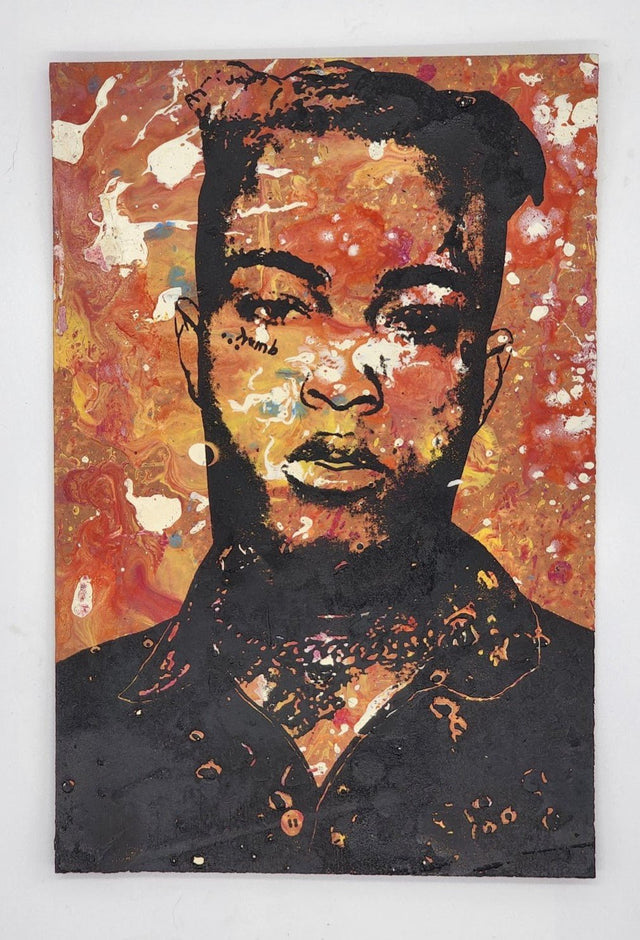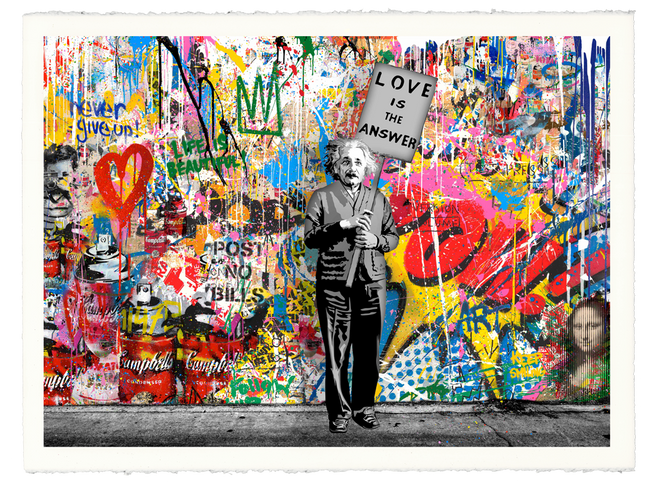
Man Male

Mr Brainwash- Thierry Guetta M=bw² Collage Large Format Silkscreen Print by Mr Brainwash- Thierry Guetta
M=bw² Collage 36x48 Large Format Silkscreen Print by Mr. Brainwash- Thierry Guetta Hand-Pulled 13-Color on Deckled Fine Art Paper Limited Edition Screenprint Artwork. 2024 Signed & Numbered Limited Edition of 18 Artwork Size 48x36 Silkscreen Print of Albert Enstine Holding Love is the Answer Sign Standing by a Highly Detailed Graffiti Tagged Wall. Confluence of Genius and Street Art: Thierry Guetta's Masterpiece In the vibrant sphere of street pop art, few pieces resonate with the intellectual depth and visual impact of "M=bw²," a commanding large format silkscreen print by the eminent street artist Thierry Guetta, known professionally as Mr. Brainwash. The 2024 signed and numbered limited edition release stands out with its striking dimensions of 48x36 inches. This print captures the iconic visage of Albert Einstein standing against a meticulously detailed wall, bathed in graffiti, with a sign declaring "Love is the Answer." This artwork is not merely a tribute to the theoretical physicist but a bold statement in the conversation between science and street pop art, merging the realms of theoretical physics with the visceral, color-splashed world of graffiti artwork. Artistic Interpretation of Einstein's Legacy Albert Einstein, a figure synonymous with genius, becomes the focal point in Mr. Brainwash's visual narrative, where the theoretical underpinnings of the universe meet the expressive freedom of street art. Guetta's piece distills the complexity of Einstein's contributions to science and his cultural significance into a single image that is as thought-provoking as it is aesthetically striking. With each of the limited 18 pieces, "M=bw²" presents a unique color palette, expertly hand-pulled across deckled fine art paper, which gives the artwork an organic edge and tactile presence that echoes the textural quality of graffiti on a brick wall. The interplay of Einstein's contemplative pose with the vibrant chaos of the background graffiti invites the viewer to reflect on the relationship between order and entropy, theory and practice, restraint and expression. This silkscreen print embodies a cross-disciplinary dialogue, encouraging interpretations that cross the borders of art, science, and philosophy. Guetta's Visual Ode to Street Pop Art and Graffiti Artwork Mr. Brainwash's choice to depict Einstein in the context of graffiti is revelatory of the artist's appreciation for the inherent wisdom and revolutionary potential within both science and street art. The "M=bw²" collage becomes a symbolic gesture, aligning the transformative power of love, as alluded to in Einstein's sign, with the transformative power of street art. By superimposing such a profound message onto a wall that bears the marks of numerous anonymous street artists, Guetta pays homage to the communal and often revolutionary spirit of graffiti. The artwork thus becomes an anchor point in the larger narrative of Street Pop Art & Graffiti Artwork, asserting the value of love as a fundamental, universal answer, much like the answers Einstein sought in his equations. In each layer of paint and every deliberate silkscreened line, "M=bw²" reflects the multifaceted nature of human knowledge and creativity. Guetta's work is a testament to the ongoing influence of iconic historical figures and the power of art to reinterpret and repurpose their legacies in ways that resonate with contemporary culture and social discourse. As a medium, street art has often been a visual language for the marginalized and the voiceless, and in "M=bw²," it articulates a message that combines the intellectual and the emotional, the historical and the immediate. Through "M=bw²," Thierry Guetta continues to shape the pulse of street art, ensuring its role not just as a mode of artistic expression but as a medium for profound social and intellectual commentary. The work serves as a reminder that the essence of significant figures like Einstein can find new life and new relevance in the hands of visionary artists and that the questions of our existence remain as pertinent in the alleys adorned with graffiti as they do in the annals of science. In Guetta's print, the message that "Love is the Answer" stands as a universal truth that traverses the domains of art, science, and human experience.
$14,000.00


